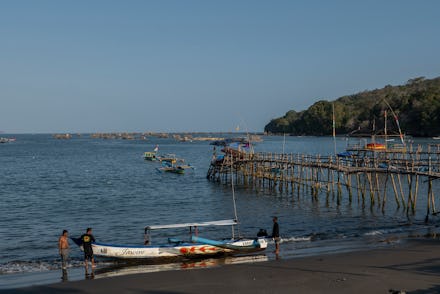How a phenomenon in the Indian Ocean contributed to Australia's devastating wildfires

When it comes to climate change, nothing really exists in isolation. The disasters you see in one area, like increased wild fires or flooding across the globe, are all influenced by other climate events. Now, scientists say global heating is super-powering an Indian Ocean dipole and that could have disastrous consequences.
First described in 1999, the Indian Ocean Dipole (IOD) is a coupled-ocean atmosphere phenomenon. It's defined by differences in ocean surface temperatures between two areas or poles, hence the name. According to the Australian Government's Grain Research & Development Corporation, IOD is where the ocean and atmosphere "feed off each other's behaviors."
In the past, the IOD has been compared to both El Niño and La Niña in the Pacific. Some people have gone so far as to nickname it the Indian El Niño. It's already been linked to flooding in Africa and bushfires in Australia, as reported by the Guardian, but the IOD may appear more regularly as ocean surface temperatures rise.
You can think of these rising temperatures as "supercharging" the IOD. At least, that's the description offered by Caroline Ummenhofer, a scientist at Woods Hole Oceanographic Institution in Massachusetts.
"There has been research suggesting that Indian Ocean dipole events have become more common with the warming in the last 50 years, with climate models suggesting a tendency for such events to become more frequent and becoming stronger,” Ummenhofer told the Guardian.
Since the 1970s, oceans have absorbed more than 93 percent of the excess heat from greenhouse gas emissions, according to a report published by the Intergovernmental Panel on Climate Change in 2013. But, something interesting has happened with that heat.
The tropical Pacific ocean used to be thought of as absorbing most of the heat from greenhouse gas emissions. However, Climate Central reported that heat in the Pacific has been decreasing since 2003, and the Indian Ocean is now home to 70 percent of all heat taken up by oceans in the past decade.
This collection of heat could lead to stronger IOD events than what was seen before. Already, flooding has displaced hundreds of thousands of people in Somalia, the Guardian reported. In addition, entire towns have been submerged in South Sudan and there's been landslides in Kenya, Ethiopia, and Tanzania.
“The new normal is a severe weather events. Looking at the Indian Ocean dipole’s effects, you have to see this is as a preview of what can be expected in other parts of world," Gemma Connell, of the UN’s Office for the Coordination of Humanitarian Affair, told the Guardian. "And while I’m not surprised that attention of the world is elsewhere, that is still unforgivable given how many are suffering from a phenomenon the rest of the world helped create.”